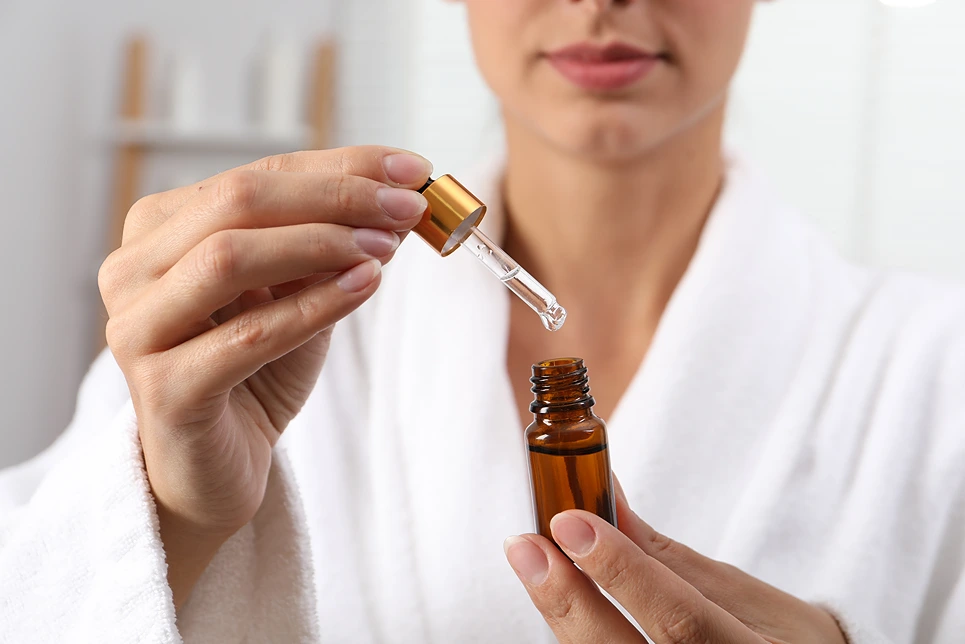How to choose the perfect dermaplaning oil for your skin type to enhance hydration, protect your skin, and maximize treatment benefits.

When choosing an oil for dermaplaning, it’s essential to select one that matches your skin type. For oily skin, opt for lightweight, non-comedogenic oils like jojoba, sunflower seed, or grape seed oil, which balance oil production and dissolve excess oil.
For dry skin, use moisturizing oils such as avocado, coconut, or argan oil to lock in moisture. Sensitive skin benefits from hypoallergenic oils like jojoba, squalane, or argan oil, which soothe and hydrate.
For normal skin, argan, jojoba, or grapeseed oil work well. The right oil enhances hydration, protects your skin, and maximizes the treatment’s benefits, ensuring smoother and healthier skin; continue to learn more about how to make the most of your dermaplaning treatment.
Choosing the Right Oil
When it comes to dermaplaning, choosing the right oil is crucial for optimizing the treatment’s benefits and addressing your specific skin needs. The type of oil you use can significantly impact the outcome, so it’s important to select one that aligns with your skin type.
For oily and acne-prone skin, opt for non-comedogenic oils that are light in texture and high in linoleic acid. Jojoba oil, sweet almond oil, sunflower seed oil, and grape seed oil are excellent choices as they won’t clog pores and can help regulate oil production.
If you have dry skin, look for oils rich in fatty acids that aid in moisture retention. Avocado oil and coconut oil are ideal for locking in moisture and repairing the skin’s barrier function.
For sensitive skin, calming oils such as chamomile oil, lavender oil, and almond oil are recommended due to their anti-inflammatory and soothing properties. Jojoba oil is also a good option as it mimics the skin’s natural sebum and is hypoallergenic.
When applying the oil, ensure it’s lightly applied to the skin before or after the dermaplaning treatment to enhance hydration and nourishment. This helps in smoother oil application techniques and maximizes the benefits of the treatment.
Considering these essential oil options will help you tailor your dermaplaning routine to your specific skin type, ensuring the best possible results.
Oils for Oily Skin

For oily and acne-prone skin, selecting the right oil for dermaplaning is key to avoiding clogged pores and regulating oil production. You need an oil that is non-comedogenic, meaning it won’t block your pores, and one that is lightweight to prevent further oil buildup.
Here are some of the best oils for oily and acne-prone skin:
| Oil | Key Benefits | Properties |
| Jojoba Oil | Mimics the skin’s natural sebum, balances oil production | Lightweight, easily absorbed |
| Sunflower Seed Oil | High in linoleic acid, dissolves excess oil | Non-comedogenic, highly absorbent |
| Grape Seed Oil | Lightens skin discolorations, does not clog pores | Lightweight, rich in antioxidants |
| Squalane Oil | Powerfully nourishing, non-comedogenic | Lightweight, improves skin elasticity |
When choosing an oil, look for those high in linoleic acid and low in oleic acid. These oils help in regulating your skin’s oil absorption and production, making them ideal for dermaplaning. Jojoba oil, for instance, has a structure similar to your skin’s natural oils, ensuring it won’t clog your pores.
Sunflower seed oil and grape seed oil are also excellent choices due to their non-comedogenic nature and high absorbency, which helps in maintaining balanced skin without exacerbating oiliness.
Oils for Dry Skin
For individuals with dry skin, selecting the right oil for dermaplaning is crucial to maintain moisture and avoid irritation. Dry skin lacks the natural moisture that other skin types take for granted, making it prone to redness, flaking, and the accentuation of fine lines and wrinkles.
When choosing an oil for dermaplaning on dry skin, look for oils that are rich in fatty acids and can aid in restoring the skin’s lipid balance. Avocado oil is an excellent option, as it acts as a moisturizing emollient that relieves and repairs the complexion. It enhances oil absorption and helps lock in moisture, making it ideal for dry and dehydrated skin.
Coconut oil is another good choice, as it forms a protective layer on the skin, locking in moisture and providing hydration. Argan oil is also highly beneficial, as it hydrates the skin deeply and softens dry patches.
These oils not only facilitate smooth dermaplaning but also provide long-lasting hydration and nourishment, making your skin feel softer and look more radiant.
These moisturizing techniques ensure that your skin remains hydrated and protected throughout the dermaplaning process, preventing further dryness and irritation. By selecting the right oil, you can enhance the effectiveness of dermaplaning and achieve healthier, more balanced skin.
Oils for Sensitive Skin

If you have sensitive skin, choosing the right oil for dermaplaning is crucial to avoid irritation, rashes, or bumps. Here are some oils that are particularly suited for sensitive skin:
Jojoba Oil
Jojoba oil is an excellent choice because it mimics the skin’s natural sebum, making it hypoallergenic and non-comedogenic.
It’s rich in antioxidants like vitamin E and B-complex vitamins, and its anti-inflammatory properties can soothe any redness or irritation caused by dermaplaning.
Its lightweight texture ensures it won’t feel heavy or leave a residue, making it ideal for even the most sensitive skin types.
Squalane Oil
Squalane oil provides intense hydration without a greasy feel, which is perfect for sensitive skin.
It improves skin elasticity, smooths fine lines, and has antibacterial properties to calm breakouts.
Being non-comedogenic, it won’t clog pores, ensuring it’s safe for sensitive and acne-prone skin.
Argan Oil
Argan oil is packed with antioxidants, vitamin E, and fatty acids, offering deep hydration that absorbs quickly without leaving a greasy residue.
Its gentle and nourishing properties make it suitable for sensitive and mature skin, helping to soften and improve skin texture.
Grapeseed Oil
Grapeseed oil is lightweight and fast-absorbing, making it great for oily or acne-prone skin.
It has mild astringent qualities that help tighten and tone the skin, and its high linoleic acid content reinforces the skin’s moisture barrier.
This oil is also rich in antioxidant vitamin E, which combats aging and reduces redness and swelling.
When applying these oils, ensure to follow proper oil application techniques: cleanse your skin thoroughly, apply a thin layer of the oil, and then proceed with dermaplaning.
The essential oil benefits, such as hydration, antioxidant protection, and anti-inflammatory properties, will help keep your sensitive skin comfortable and healthy throughout the process.
Oils for Normal Skin
When your skin is well-balanced and neither too dry nor too oily, you’re looking for oils that maintain this equilibrium while providing additional benefits. For normal skin, the goal is to enhance its natural health and appearance without causing any imbalances.
Here are some essential oils and natural oils that are ideal for normal skin:
1. Argan Oil
Rich in fatty acids, vitamin E, and antioxidants, argan oil helps to moisturize and protect your skin from environmental stressors. Its lightweight texture absorbs quickly, leaving your skin soft and supple.
2. Jojoba Oil
Jojoba oil is known for its ability to balance sebum production, making it an excellent choice for normal skin. It’s ultra-soothing, non-comedogenic, and rich in anti-inflammatory properties.
3. Grapeseed Oil
Grapeseed oil is rich in linoleic acid, an omega-6 fatty acid that helps keep pores unclogged and reduces the risk of breakouts. It offers moisturizing properties and protects against sun damage.
4. Marula Oil
Marula oil, with its high content of antioxidants and omega fatty acids, moisturizes the skin and protects it from environmental stressors. It absorbs quickly and provides a silky, soft feel to the skin.
In terms of application techniques, it’s best to use a few drops of these oils after cleansing and toning your skin.
Gently massage the oil into your face until it’s fully absorbed to maximize its moisturizing properties. This helps maintain the natural balance of your skin while providing additional nourishment and protection.
Benefits of Post-Dermaplaning Oils

Post-dermaplaning oils play a crucial role in enhancing the benefits of the treatment and ensuring your skin remains healthy and nourished. After dermaplaning, your skin is sensitive and vulnerable, making it essential to use the right oils as part of your post-dermaplaning care.
These oils help in skin barrier repair by providing intense hydration and protection. Natural, non-comedogenic oils are ideal as they don’t clog pores and allow your skin to breathe. Oils rich in antioxidants and essential fatty acids can calm redness, reduce inflammation, and support the skin’s natural repair processes.
Using post-dermaplaning oils also enhances the penetration of other skincare products. Since dermaplaning removes the top layer of dead skin cells, oils can sink deeper into the skin, maximizing their benefits. This leads to smoother, more evenly toned skin and better absorption of serums and moisturizers.
Additionally, these oils can help minimize the appearance of fine lines and acne scarring, which are common concerns addressed by dermaplaning. By maintaining a healthy skin barrier, you can enjoy a radiant, glowing complexion for a longer period.
Ensure to choose oils that are gentle and free from harsh ingredients to avoid any irritation during the sensitive post-treatment phase.







